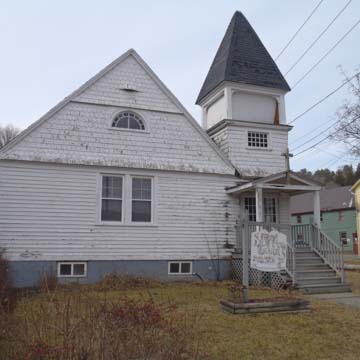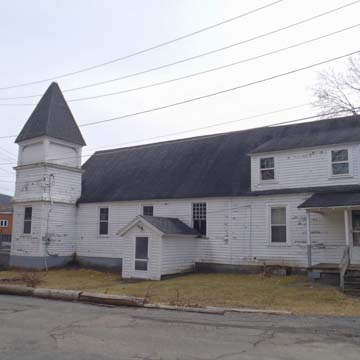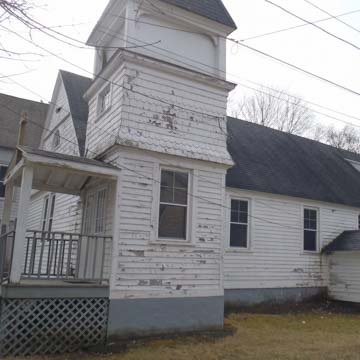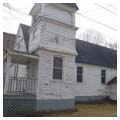Built in 1886 as the first Black church in Berkshire County, the Clinton African Methodist Episcopal (AME) Zion Church is located just off of Great Barrington’s main thoroughfare. It served not only as a house of religious worship, but also functioned as a cultural and political institution in which the African American community could exert power in a world predominantly shaped by white residents. The Clinton AME Zion Church also reveals demographic changes taking place in the African American population when, following the Civil War and emancipation, many Black southerners moved northward.
This modest Shingle Style building reflects profound changes in the nation’s religious institutions, and should also therefore be understood in both regional and national contexts. In 1814, the African Methodist Episcopal Church formed in Philadelphia after severing ties with the Methodist Church over racial discrimination. One of the AME Church’s founders and an important African American leader, Bishop Richard Allen, worked tirelessly to end racial subjugation, build the new Church, and lead missionary efforts to liberate Black people from both slavery and White-dominated religions. The AME Zion Church split from the AME Church in 1821 over governance disputes. Both of these religious institutions asserted Black autonomy, fought for abolition and racial equality, and evangelized in the South following the Civil War.
Both free and enslaved African Americans had lived in Great Barrington since the mid-eighteenth century. The ancestors of the eminent sociologist and civil rights leader, W.E.B. DuBois (who attended some services at Clinton AME), were brought to town during this period as slaves, but their Dutch master freed them following the American Revolution. After Massachusetts banned slavery by judicial decree in 1783, the region around Great Barrington became a haven for both freemen and escaped slaves from the adjacent states of New York and Connecticut. These states passed gradual manumission laws in the late eighteenth century that did not effectively end slavery until 1837 and 1848, respectively.
Though industrialization brought increased employment to Great Barrington and western Massachusetts, most factories refused to hire from this local population. Census records from the 1850s to the 1930s show that African Americans in Great Barrington worked primarily in domestic settings or as general or agricultural laborers. In the nineteenth century, the Berkshires developed into a popular tourist destination, and hotels, inns, and other associated services industries provided many jobs for the area’s growing Black population.
Though the Clinton AME Zion Church did not keep systematic records until 1936, scholars believe that the congregation began meeting in the 1860s, with the first documented gathering in 1870. The new congregation named its church for the AME Zion Bishop Joseph Jackson Clinton, a leading missionary for the AME Church. From its earliest years, the church included both established families from Great Barrington and the wider region as well as newcomers from the South. After years of fundraising, the congregation purchased a parcel of land on Elm Court, a small lane a block away from Main Street, and began construction of the sanctuary in 1886. Though near the town center, the Clinton AME Zion Church occupied a far less prominent location than the town’s white churches enjoyed. The site was several yards from the railroad tracks, while the First Congregational Church and St. James Episcopal stood on Main Street—Great Barrington’s civic and commercial center.
The completed sanctuary consisted of a simple wood-framed building, gable end to the street, with a two-story square entry and bell tower at the northeast corner. White-painted clapboard siding covers the majority of the building’s first floor, but decorative shingles with alternating bands of round and square edges cover the gable. The sanctuary represented the collaborative effort of its members, who not only raised the money for its construction, but also donated furniture and labor. The building is a vernacular expression of the Shingle Style, a design popular among those building vacation houses in area. The interior consists of a small, roughly square room with exposed wood trusses and plastered walls above wainscoting. The informal and intimate space contrasted greatly with the Euro-American churches from which the Clinton AME Zion Church had separated. The Clinton Church did not have the weight of denominational requirements for worship spaces or a tradition of church design; thus, the community could make the building conform to its needs. Overall, the church’s excellent design and solid craftsmanship heightened the community’s esteem in the Great Barrington region.
Most important, the Clinton AME Zion Church afforded the African American community a new level of religious, cultural, and political autonomy. In the last decades of the nineteenth century and throughout the twentieth, the congregation held meetings at the church to discuss ongoing political movements for racial justice and equality, organized fundraising and social events aimed at strengthening community, and practiced a religion developed specifically to address African American needs. The church grew and adapted over the years by adding a parsonage in 1939 and digging out a basement for a communal space in the late 1940s. In the 1960s, leaders of the Church advocated for better police treatment of African American youths and gained seats on a police relations and county human relations committee. The local chapter of the NAACP, founded on a national level by W.E.B. DuBois, periodically met at the Clinton AME Zion Church.
The congregation has kept the building in exceptional condition into the twenty-first century, making few alterations to the original structure. In recognition of its significant role in the history of African Americans in Great Barrington and Berkshire County, the Clinton AME Zion Church was listed on the National Register of Historic Places in 2008. Membership in the original AME Zion congregation, though, has dwindled over the past decade, and the church now houses the largely African American Macedonia Baptist Church’s congregation, which had shared the space with the AME Zion church for nearly fifty years. The building remains a vital element of the religious, cultural, and political life of the area’s Black community. Unfortunately, however, the Clinton AME Zion Church now languishes in disrepair.
References
Grover, Kathryn and Neil Larson, “Clinton African Methodist Episcopal Zion Church,” Berkshire County, Massachusetts. National Register of Historic Places Registration Form, 2008. National Park Service, U.S. Department of the Interior, Washington, D.C.
Newman, Richard. Freedom’s Prophet: Bishop Richard Allen, the AME Church, and the Black Founding Fathers. New York: New York University Press, 2008.



















